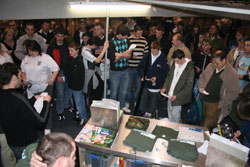THE European tackle trade is now worth €3.8 billion ($5.39 billion US) according to a new survey unveiled by Tackle Trade World magazine.
This is just one of the results of a major study of the European tackle trade conducted by this magazine over the past 12 months.
In total more than 2000 companies across 42 European countries were contacted via e-mail to collate the figures. While in the UK, results were produced from a postal survey carried out late last year by its own trade magazine Tackle & Guns.
One other prominent headline figure is that Europe now has more than 60 million anglers out of a population of just more than 800 million.
The groundbreaking investigation has unveiled some interesting facts about the size of the European territory and not only raises many questions, but also highlights the huge growth potential for the sport.
While a number of countries are now classed as mature, it’s clear many of the leading brands are now heavily targeting emerging territories.
The biggest population of anglers can be found in Russia, where they have just more than 15 million (although many believe the figure could be as much as 30 million), followed by Turkey with five million.
Currently, it is unknown how many anglers in Russia are fishing for sport and how many are fishing for the pot. What we do know is that they are using sport fishing tackle to do the job.
It has been reported by several of the big hook manufactures in the world for example, that they sell bulk hooks to these regions and know that they are then repackaged as individual hooks, or packets of three or five, to cater for the demand.
Both Russia and Turkey are considered ripe to develop, particularly as they account for a third of all anglers across the continent.
In fact Russia already sits well up the pecking order in terms of turnover at €150 million ($212 million US) well ahead of many established tackle markets.
Conversely, it has one of the smallest average salaries, with the average Russian earning €4460 ($6320 US) per year. Turks, on the other hand, earn slightly more with an average annual salary of €4710 ($6674 US).
Low yearly salaries also suggest possible areas across Europe that could offer cheaper or comparable manufacturing costs to China and could drastically reduce the ever-crippling transportation costs for firms. Highlighted countries would have to be the Ukraine and Moldova. In fact, the Ukraine is already being increasingly used as a manufacturing base.
However, it is the ‘old’ countries that still lead the way – with UK topping the list with a retail tackle trade turnover of €721 million ($1 billion US), closely followed by France €540 million ($765 million US), the Netherlands €500 million ($708 million US), Italy €420 million ($595 million US) and Germany €320 million ($453 million US).
The survey also revealed that there are more than 46,000 outlets within the 42 European countries that sell fishing tackle of some kind, 34,000 of which would be described as fishing tackle shops.
With such a huge number of sellers it’s no surprise that angling is a big employer. Sport fishing now accounts for 145,773 jobs in Europe. These are directly related to the retail and supply chain.
The survey
TTW carried out its e-mail survey by issuing nearly 2,000 questionnaires to trade members in the various countries. The return rate was 7.8 per cent – nearly double the average return rate on a questionnaire.






